by Brooke Saari | Mar 3, 2013
National Invasive Species Awareness Week: March 3rd – March 8th
March 3rd: Tropical Soda Apple (Solanum viarum) & Lionfish (Pterois volitans):
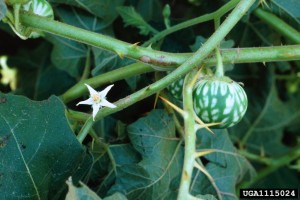
Tropical Soda Apple Photo Credit: Jeffrey Mullahey, UF, Bugwood.org
Tropical Soda Apple: Florida ranchers know Tropical Soda Apple (TSA) as the “Plant from Hell.” It was first noticed in south Florida, but its seeds survive in the digestive tracts of animals and it spread north through the movement of hay and cattle. TSA plants are covered with thorns and can make large sections of pasture nearly useless for livestock. Concerted efforts to lessen the population of TSA since its arrival have reduced the populations in pastures but it persists in sheltered or waste locations. Cattle, birds, deer and feral hogs ingest the mature fruits and spread the plants to loafing and browsing areas that may be inaccessible to mechanical treatment with anything larger than a hoe. According to Dr. Jeff Mullahey, who has been working on TSA since its appearance in south Florida, one plant can produce 40,000-50,000 seeds with seed germination ranging from 75%-100%. The seeds remain viable for at least three years. Be on the lookout for these while engaged in outdoor activities.
Isolated plants can be controlled by mechanical means. You won’t want to pull them up barehanded, though. Additional information and control methods are available at http://edis.ifas.ufl.edu/uw097, or contact your local Extension agent.
For more information contact the author Jed Dillard, Livestock & Forages Extension Agent by phone at 850-342-0187 .
.
Lionfish: The Red Lionfish is a non-native invasive predatory reef fish that has spread throughout Florida waters. Lionfish are members of the family Scorpaenidae; all members are venomous and the lionfish is no exception. This fish is relatively small, typically ranging from 12-15 inches in length with a zebra-like appearance and long, showy pectoral fins. They have a row of long, dorsal spines that contain venom glands. Their native range is the South Pacific and Indian Oceans and preferred habitat is on offshore reef structures. These fish are considered to be voracious eaters feeding on native fish, reducing vital native populations, and competing for food with native fish such as grouper and snapper.
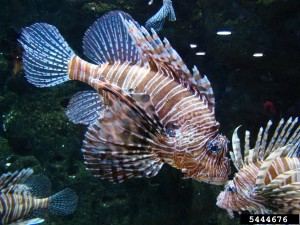
Lionfish, Photo Credit: Rebekah D. Wallace, UGA, Bugwood.org
With few predators, these fish are thriving in Florida waters, even in the northern Gulf of Mexico. They reproduce often, sometimes all year, with their eggs hatching after about two days. They also consume a variety of local species, causing 80% decline in reef fish recruitment and loss of some economically important species. These fish are able to expand their stomachs for large meals and can survive starvation for over 12 weeks. These fish are an invasive species in our local waters and removal is encouraged. The most effective control of this species is removal by human. These fish are cryptic and nocturnal so locating them can be tricky. Spearfishing is the method of choice, since lionfish rarely bite a hook and line. Florida Fish and Wildlife Commission (FWC) changed regulations to increase harvesting opportunities. Such changes include no requirement for a recreational fishing license when using spearing devices (pole spear, a Hawaiian Sling, handheld net, or spearing devices marked for use on lionfish), and no recreational or commercial bag limit, though recreational fishing license is required for other fishing methods. Check the FWC regulations before fishing or diving for these species.
Lionfish are venomous and must be handled carefully. Venom glands occur on the dorsal, pelvic and anal spines. Lionfish sightings should be reported at 877.786.7267 . If stung seek medical attention as soon as possible. Rarely are stings fatal unless the person has an allergy to the venom. The Poison Help Hotline can be reached at 800.222.1222
. If stung seek medical attention as soon as possible. Rarely are stings fatal unless the person has an allergy to the venom. The Poison Help Hotline can be reached at 800.222.1222 . Sighting information is being collected to track the movement of these species. Fill out the online report on the USGS website or the REEF website. Stay up to date on research as it pertains to this species at www.flseagrant.org.
. Sighting information is being collected to track the movement of these species. Fill out the online report on the USGS website or the REEF website. Stay up to date on research as it pertains to this species at www.flseagrant.org.
For more information contact the author Brooke Saari, Sea Grant Marine Science Extension Agent, 850-689-5850
by Brooke Saari | Mar 2, 2013
National Invasive Species Awareness Week: March 3rd – March 8th
March 2nd: Chinese Tallow (Sapium sebiferum) & Torpedo Grass (Panicum repens)
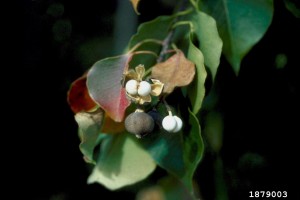
Chinese Tallow Photo Credit Cheryl McCormick, UF, www.bugwood.org
Chinese Tallow (Popcorn Tree): Benjamin Franklin has been blamed for introducing the invasive exotic Chinese Tallow tree to the Southeast when he mailed seeds to a planter after one of his trips to London in the late 1700’s. However, recent DNA work has traced the invasive strain to federal scientists’ importations in 1905. No matter. The “Popcorn Tree,” as it’s also called because of its white seeds, has invaded the Gulf of Mexico coast from Texas to Florida, especially the wetlands and bottomland forests. A mature tree may produce as many as 100,000 seeds annually. These seeds can be spread by birds or moving water and expedite the trees’ takeover of habitat. The sap and berries are toxic to humans and livestock. It has been planted for its red fall color, but it crowds out native wetland species such as black gum and red maple, both noted for their red fall leaves. Its tolerance to flooding and saltwater can also make it a threat to bald cypress.
Recently research by scientists of the US Forest Service and others has shown that dissolved oxygen and pH levels in the leaf litter of the tallow tree are fatal to the early stage eggs of the leopard frog. While tallow trees provide a nectar source for bees and have been investigated as a biofuel source, the damage to wetlands caused by these invaders more than offsets the positive aspects of the plant.
To control this species, small seedlings may be hand pulled, especially in wet areas, but care should be taken to leave no root pieces to resprout. Herbicides including triclopyr can control Chinese Tallow. More information is available at http://edis.ifas.ufl.edu/ag148 and http://plants.ifas.ufl.edu/node/676. For local assistance, contact your county UF IFAS Extension office.
For more information contact the author Jed Dillard, Livestock & Forages Extension Agent,850-342-0187 .
.
Torpedo Grass: Torpedo grass (Panicum repens) is an invasive weed that is a scourge in lawns, flowerbeds and landscapes. Even if introduced into a small area, this weed can rapidly spread to become a major problem. Its name is derived from the hard, sharp point of the rhizome that runs horizontally underground, almost like a torpedo going through water. The rhizomes can travel a foot or more deep, and the hard tip will easily punch through landscape fabric and weed barriers.
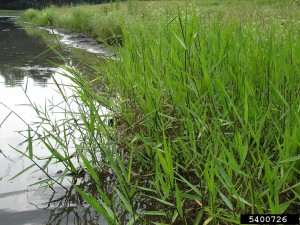
Torpedo Grass Photo Credit: Graves Lovell, Alabama Department of Conservation & Natural Resources, www.bugwood.org
Native to Africa and Asia, Torpedo Grass was introduced to the United States around 1876, primarily through seed used for forage crops. The real infestation came in the early part of the 20th century when the USDA imported and distributed seed for planting pastures as forage for cattle. Ironically it proved inferior for use as a forage crop. Now it is found in the Gulf South from Florida to Texas and in other coastal areas around the world.
Torpedo grass is nearly impossible to completely eliminate, so management of it is not a matter of how to get rid of it completely but instead how to prevent it from taking over an area. The only way that this can be accomplished is with repeated and frequent efforts. You will have to scout regularly and any time torpedo grass is seen, promptly take action. Prevention is best for management of this weed, mechanical provides moderate control, and the most effective is herbicide use. Glyphosate (Roundup, etc.) has been found to be the most effective control herbicide but specific chemicals and application techniques will vary depending upon the landscape or habitat characteristics. For management in lawns please refer to http://edis.ifas.ufl.edu/ep387 for specific herbicide controls based predominate lawn species. For management of invasive species in natural areas, refer to http://edis.ifas.ufl.edu/wg209 for a comprehensive list of species and their controls. As always, refer to instructions on herbicide label to ensure proper usage. Understand that herbicides will suppress torpedo grass for a time, but they will not kill it. Unfortunately, at this time, there is no quick, easy or permanent way to deal with this weed.
For more information contact the author Rob Trawick, Horticulture Extension Agent,850-482-9620 .
.
by Brooke Saari | Mar 1, 2013

National Invasive Species Awareness Week
Invasive Species Awareness: How is Your Invader Knowledge?
Invasive species are non-native or exotic species that do not naturally occur in an area and cause economic or environmental harm or harm to human health. These invasive species have become the number one threat to biodiversity on protected lands. However, invasive species do not know boundaries and as a result public and private lands are affected as well as natural and man-made water bodies and associated watersheds. Northwest Florida is home to many unique habitats, including upland, wetland, and marine. These habitats, housing a variety of plants and animals, make this area considered as one of the top six biodiversity hotspots in the country. These invasive species threats can come in the form of both plants and animals, in Florida there are over 500 non-native fish and wildlife species and over 1180 non-native plant species that have been documented. Exotic species are able to outcompete many natives causing habitats to degrade, animals to leave, and can introduce diseases that can destroy economically important species. This is a worldwide issue that can be addressed on local levels. One of the most effective ways to control invasive species is by prevention, just by becoming invasive aware can help to control some of these issues.
So how aware are you? Recreationalists such as boaters, fishermen, pet owners, gardeners, hikers and travelers can be unknowing dispersers of invasive species. These everyday steps can help: By cleaning and draining your boat, gear and trailer between water bodies can stop the spread of species that may be hitchhiking on your equipment. If you are a pet owner and find yourself in a possession of a pet you no longer want or can care for, it is important not to release these into the wild. No pet, either native or exotic, should ever be released. This act can cause more harm than good, not only to your pet but to the other native wildlife. Follow the simple tips on Habitattitude to get tips on alternatives to releasing your pet. When out enjoying nature while biking, hiking, camping, birding, etc. take care to check where you are trekking, what might have attached to your clothing, making sure you do not end up being an unwitting disperser. Gardeners, even you can help especially when dealing with non-native plant dispersal. Not all non-native plants are bad but make sure that the plants you are putting in your garden are not harmful invaders that will make it into natural areas. Verify your plants by making sure they do not occur on the invasive plant list which can be found at http://www.fleppc.org/. There are many ways to get involved in the battle against invasive species. For more information about National Invasive Species Awareness Week (NISAW) please visit http://www.nisaw.org/, landowners can join your local Cooperative Invasive Species Management Areas (CISMA) group or for more info on local invasive species contact your UF/IFAS extension office. Look for the invasive species of the day posts on the Panhandle Outdoors Extension Newsletter blog throughout NISAW to increase your awareness of local invasive exotic species.
For more information, please contact Brooke Saari, Florida Sea Grant Marine Science Agent, Okaloosa/Walton County UF/IFAS Extension by phone 689-5850 or email bsaari@ufl.edu.
by Rick O'Connor | Nov 26, 2012
The Invasion of the Lionfish
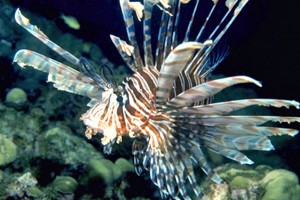
(Photo: Florida Sea Grant)
It is a song that has been played in our state time and again. An exotic pet or plant is brought across our borders and either intentionally or accidentally released into the environment. Tropical fish, exotic reptiles, and nonnative mammals escape and the next thing you know they are wandering the neighborhood.
In many cases these non-natives are just another part of the landscape but some species they become invasive and cause economic or environmental problems. There are many examples of invasives in Florida; iguanas, fire ants, Chinese tallow, Japanese climbing fern, and most recently – Burmese pythons. The states of Florida and Hawaii have the largest problems with these creatures thus they
have some of the toughest laws dealing with them; there is a $1000 fine for releasing in Florida. These creatures find plenty of food, few predators, and warm temperatures year round. It is no different in the Gulf of Mexico. Many tropical fish released into our waters do not survive the winters or the high salinities, but conditions are great for the lionfish.
The lionfish is from the western Pacific and range from Micronesia to the southern shores of Japan. They are cryptic and nocturnal in habit so detection difficult. They are found primarily on offshore reefs and feed on a variety of small fishes, shrimps, and crabs; they have few natural predators.
So how did they get here?
It is believed that the lionfish issue began with the aquarium trade. The most popular explanation for their release is the destruction of housing during the heavy hurricane seasons. The earliest record of a lionfish in Florida was in 1985 in the town of Dania. The first records in the northern Gulf were in 2010 when lionfish were seen in Apalachicola and Pensacola.
Are they invasive?
The answer is yes. These fish are voracious feeders consuming over 50 species of reef fishes, shrimps, crabs, and some accounts show them feeding on small spiny lobsters; many are economically important to us.
So what do we do about it?
The method of choice at the moment is removal by humans. Lionfish do not typically bite a hook so the most effective method is spearfishing. Many areas are hosting “Lionfish Rodeos” which reward divers for returning as many as possible. A rodeo held in Destin during the summer of 2012 landed 81 lionfish in a single day. On August 3, 2012 the state of Florida issued an executive order that will allow spear fishermen to capture lionfish without a saltwater license and no bag limit. This executive order will be effective for one year. Some communities consume lionfish and their flavor rating is good. However the FDA reported that lionfish live and feed on similar prey that many species of reef fish that develop ciguatera do. Though there have been no confirmed reports of ciguatera in lionfish there is a risk.
You can read more on this article at http://escambia.ifas.ufl.edu/marine/2012/08/17/the-invasion-of-the-lionfish or contact the Sea Grant agent at your local extension office.
by Scott Jackson | Nov 21, 2012
Forest management? Wild Life Habitat? History?
No matter what your interest, the December 6 Forest Stewardship Tour at Waukeenah Plantation in southern Jefferson County will give you an onsite vision of developing a forest on your property. Waukeenah Plantation was purchased by its current owners just a little over twenty-five years ago. Since then, pines have replaced pastures and the property is being managed for timber production and wildlife habitat. The day’s program will be hosted by the Florida-Georgia Game Management Series and the University of Florida Forest Stewardship program and will feature how habitat can be developed and enhanced in a relatively short time.
This is just the latest change in the use of this land. Long before Hernando deSoto camped here, indigenous peoples enjoyed the clear streams and fertile lands near the Cody Scarp. In the early nineteenth century, planter Robert Gamble set up the original Waukeenah Plantation. In addition to the recently planted pines, the site boasts hardwoods in the creek bottoms. Tour stops will visit both and discuss the management of each to enhance wildlife habitat. Tour leaders will include speakers from the University of Florida and University of Georgia Extension Services, the Florida Department of Forestry, National Wild Turkey Federation, the USDA Natural Resources Conservation Service and the Florida Public Archeology Network.
For more information, contact Jed Dillard at dillardjed@ufl.edu or 850-342-0187. Register online at http://flgaextgamemgmt2012.eventbrite.com/# . Registration is limited and required.






